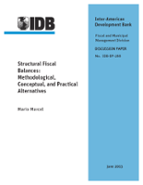Structural Fiscal Balances: Methodological, Conceptual, and Practical Alternatives
Date
Jul 2013
This paper discusses the merits of alternative definitions of the structural budget in the context of their use in the design and implementation of fiscal rules. To this end, the paper argues that there are three different purposes behind the notion of a structural budget balance: (a) separating permanent from temporary fiscal changes, (b) separating the cyclical from noncyclical components, and (c) separating discretionary from non-discretionary changes. This could lead to the interpretation of the structural budget balance as a permanent balance, a cyclically-adjusted balance, or a discretionary balance, respectively. The paper identifies and measures the items that differentiate the three concepts, and assesses each one on the basis on their analytical soundness, their methodological requirements, their empirical feasibility, and their usefulness as the basis of a fiscal rule.




